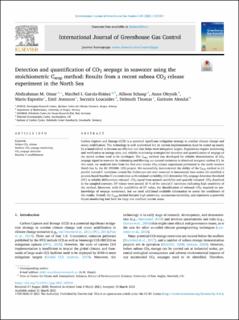| dc.contributor.author | Omar, Abdirahman | |
| dc.contributor.author | García-Ibáñez, Maribel I. | |
| dc.contributor.author | Schaap, Allison | |
| dc.contributor.author | Oleynik, Anna | |
| dc.contributor.author | Esposito, Mario | |
| dc.contributor.author | Jeansson, Emil | |
| dc.contributor.author | Loucaides, Socratis | |
| dc.contributor.author | Thomas, Helmuth | |
| dc.contributor.author | Alendal, Guttorm | |
| dc.date.accessioned | 2022-04-26T07:50:45Z | |
| dc.date.available | 2022-04-26T07:50:45Z | |
| dc.date.created | 2021-05-12T11:32:28Z | |
| dc.date.issued | 2021 | |
| dc.identifier.issn | 1750-5836 | |
| dc.identifier.uri | https://hdl.handle.net/11250/2992692 | |
| dc.description.abstract | Carbon Capture and Storage (CCS) is a potential significant mitigation strategy to combat climate change and ocean acidification. The technology is well understood but its current implementation must be scaled up nearly by a hundredfold to become an effective tool that helps meet mitigation targets. Regulations require monitoring and verification at storage sites, and reliable monitoring strategies for detection and quantification of seepage of the stored carbon need to be developed. The Cseep method was developed for reliable determination of CO2 seepage signal in seawater by estimating and filtering out natural variations in dissolved inorganic carbon (C). In this work, we analysed data from the first-ever subsea CO2 release experiment performed in the north-western North Sea by the EU STEMM−CCS project. We successfully demonstrated the ability of the Cseep method to (i) predict natural C variations around the Goldeneye site over seasonal to interannual time scales; (ii) establish a process-based baseline C concentration with minimal variability; (iii) determine CO2 seepage detection threshold (DT) to reliably differentiate released−CO2 signal from natural variability and quantify released−CO2 dissolved in the sampled seawater. DT values were around 20 % of the natural C variations indicating high sensitivity of the method. Moreover, with the availability of DT value, the identification of released−CO2 required no pre-knowledge of seepage occurrence, but we used additional available information to assess the confidence of the results. Overall, the Cseep method features high sensitivity, automation suitability, and represents a powerful future monitoring tool both for large and confined marine areas. | en_US |
| dc.language.iso | eng | en_US |
| dc.publisher | Elsevier | en_US |
| dc.rights | Navngivelse 4.0 Internasjonal | * |
| dc.rights.uri | http://creativecommons.org/licenses/by/4.0/deed.no | * |
| dc.title | Detection and quantification of CO2 seepage in seawater using the stoichiometric Cseep method: Results from a recent subsea CO2 release experiment in the North Sea | en_US |
| dc.type | Journal article | en_US |
| dc.type | Peer reviewed | en_US |
| dc.description.version | publishedVersion | en_US |
| dc.rights.holder | Copyright 2021 The Author(s) | en_US |
| dc.source.articlenumber | 103310 | en_US |
| cristin.ispublished | true | |
| cristin.fulltext | original | |
| cristin.qualitycode | 1 | |
| dc.identifier.doi | 10.1016/j.ijggc.2021.103310 | |
| dc.identifier.cristin | 1909652 | |
| dc.source.journal | International Journal of Greenhouse Gas Control | en_US |
| dc.relation.project | Norges forskningsråd: 254711 | en_US |
| dc.relation.project | EC/H2020/294766 | en_US |
| dc.relation.project | EC/H2020/654462 | en_US |
| dc.identifier.citation | International Journal of Greenhouse Gas Control. 2021, 108, 103310. | en_US |
| dc.source.volume | 108 | en_US |

